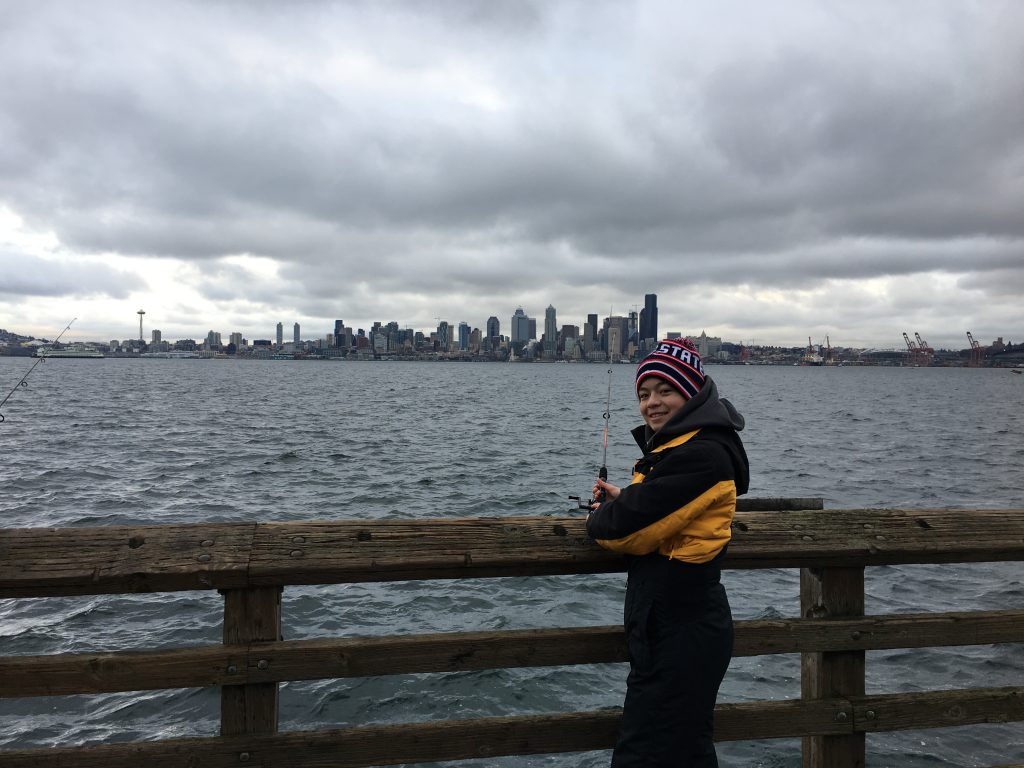Time to kick up your feet doing the jig around Puget Sound and reel-in a bucket of squid Leave a reply
Nighttime along many Puget Sound piers has come to life and the motive behind anglers hanging their hopes off the sides of these structures are the massive amount of squid now pouring into marine waterways.
Squid – known in the culinary biz as “calamari” – are very plentiful marine creatures that attract hordes of anglers to waterfront piers as millions of these slimy, ink squirting creatures return to spawn in Puget Sound.
“We’ve had a big push of squid the last couple of weeks but it has been excellent since the middle of summer at the Edmonds Pier, and now it has spread south to Seattle, Des Moines and the Tacoma areas too,” said Mike Chamberlain, owner of Ted’s Sports Center in Lynnwood.
“The squid jigging has been pretty consistent with some days guys getting 10 pounds in an hour at Edmonds to other times when you have to work for them,” Chamberlain said. “It all varies from night to night, and sometimes there are variables that will slow it down like then the seals and sea lions come in to feed that’ll definitely disrupt how good fishing is. I’m confident we’re in for another good squid year and the past four seasons were outstanding.”
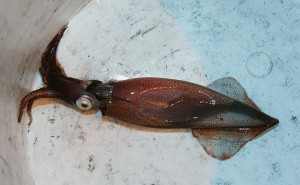
Good squid jigging has become a nightly affair in recent weeks at the Les Davis Pier in Tacoma, Des Moines Marina Pier and the Seacrest Boathouse Pier in West Seattle.
The majority of the squid are small, 4 to 6 inches, but will grow larger as the season progresses into winter. Just before spawning squid will gorge on small baitfish and crustaceans.
Puget Sound is a haven each year for returning squid as they lay eggs along the gentle sloping rocky bottoms in water 15 to 60 feet deep.
Night-time on a flood tide are the best periods to catch squid as they’re attracted to lighted public piers. Squid like to lurk in the darker edges of lighted water and will dart out into the light on their unsuspecting prey.
Puget Sound squid are commonly known as “Pacific squid” or “market squid” and measure 4 to 12 inches with a short-term life cycle of about 18 months.
There are more than 300 species of squid that inhabit the ocean and inner-marine waterway including the giant Humboldt squid that can weigh up to 100 pounds and grow in length to eight feet long.
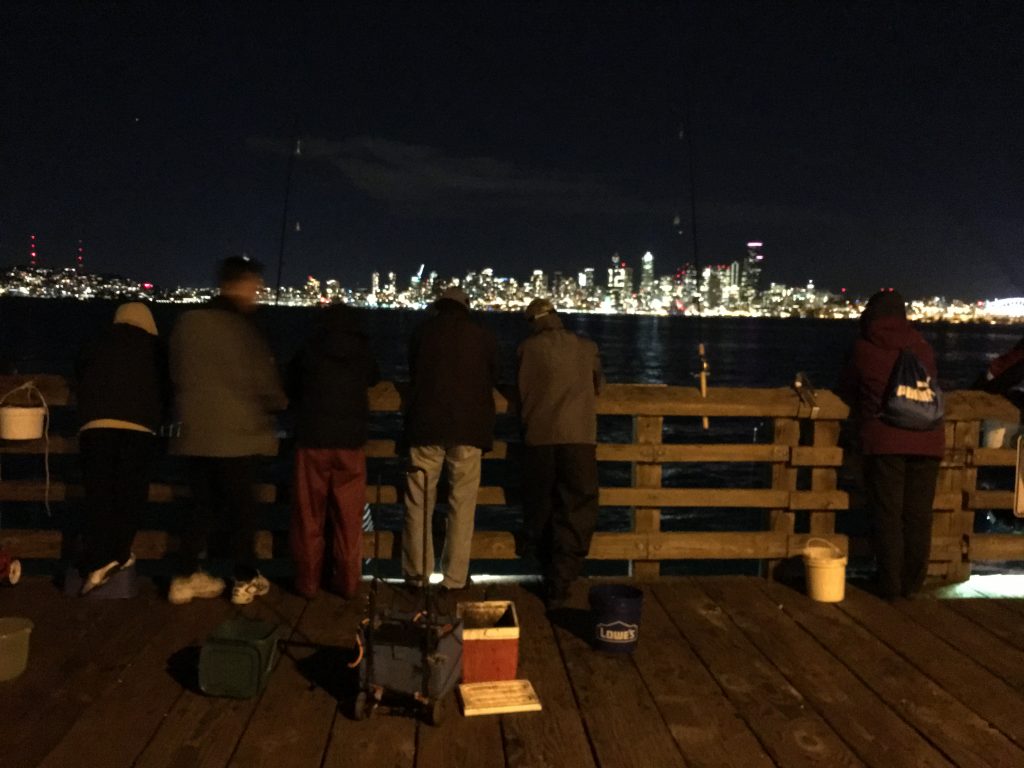
All squid have a common defense mechanism that’s shoots a dark blue, black-colored ink out of their body as they flee from predators. It is not uncommon to find anglers on the docks who get “inked” after landing them. The main compound in squid ink is melanin, which is the pigment responsible for the ink’s dark color and an interesting fact is that this also occurs in humans and determines your skin color.
Squid usually start to appear in September, and the best jigging usually happens from mid-October through February, but it isn’t uncommon to catch them in late summer as has been the case the past few seasons.
Unlike many other sport fisheries, it doesn’t take a lot of skill to catch squid and usually a simple trout-style fishing set-up will get the job done.
Use a sensitive long-length rod and spinning reel with lightweight fishing line of 5- to 6-pound test. The lighter line will help you feel the subtle tap or vibration of an attacking squid.
Weighted luminous or light-up plastic jigs come in a wide range of colors like pink, chartreuse, blue, red, green, orange or no-color at all. Jigs don’t have “hooks” and instead have upward slanting sharp prongs. Unweighted lures are also used by squid jiggers that attach to a one-ounce lead weight to the bottom of the jig.
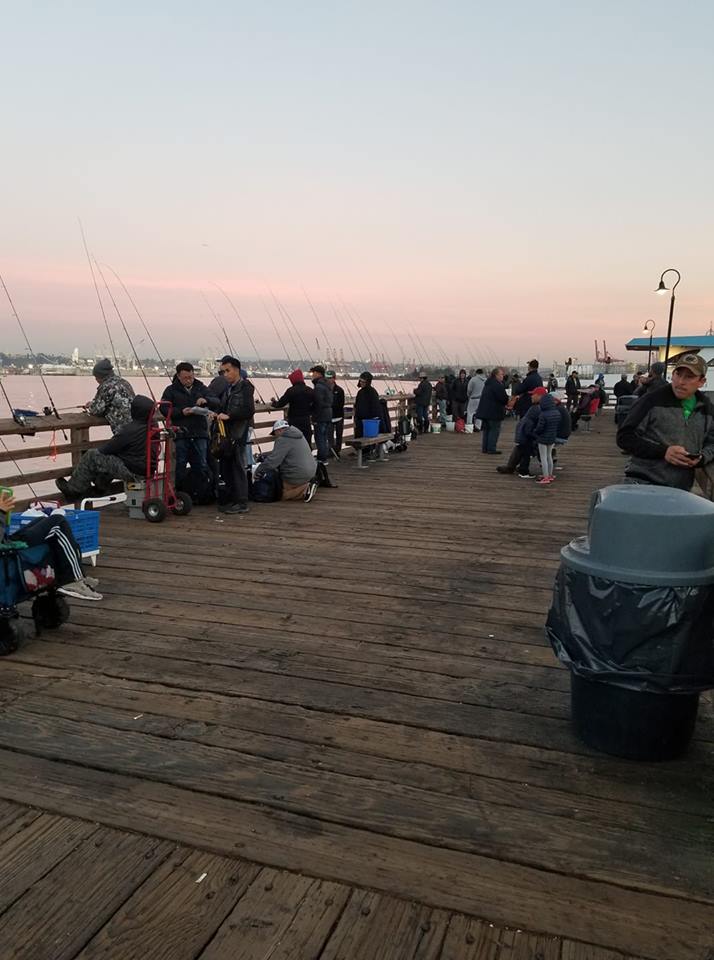
You can also tie multiple jigs to the mainline but note that regulations say no more than four lures may be used at one time.
Squid don’t bite a jig and will wrap their tentacles onto the jig’s prongs. This is where a steady upward pressure when reeling them in and giving no slack in the line is effective otherwise they’ll let go.
Raise the rod tip up to about 10 o’clock and then slowly lower the jig back down to make it resemble an injured fish.
Squid school anywhere from just below the water’s surface to about 20 to 25 feet down, but it’s good to work your lure from top to bottom in the water column to catch them.
Peak time catch squid is during or right at flood tide. Many anglers claim it is best during middle of the night, but often squid fishing will stay good through the early-morning hours. When plentiful you can even catch them on a mid-day flood tide.
WDFW rules state the daily limit is 10 pounds or 5 quarts, plus up to five Humboldt squid; each angler must keep their catch in separate containers; no more than four lures may be used at one time; a forage fish dip-net or hand dip net may be used; and there is no minimum size limit for squid.
A state shellfish license is required for ages 15 to 69, and 70 and older will need a senior shellfish license.
Being mobile will pay off for those who pursue squid so if the fishing is slow at one pier be sure to move to another location.
The Seattle waterfront at Piers 57, 62, 63, 70 or the Seattle Aquarium Pier are the most popular locations for Seattleites.
Pier 86 off Elliott Avenue used to be the hotbed for squid jigging but was closed in 2017 until further notice due to safety concerns. The WDFW is trying to determine the fate of the pier, since repairs to fix the cracked piers as well as failing electrical and water systems will be costly. Further south, the Redondo Pier also remains closed due to safety issues.
Other popular locations are the Edmonds Pier; Des Moines Pier; A-Dock and Shilshole Pier; Point Defiance Park Pier; Fauntleroy Ferry Dock; Illahee State Park Pier; and the Waterman and Indianola piers in Kitsap County.
The WDFW website has a wealth of information on squid jigging at http://wdfw.wa.gov/fishing/shellfish/squid/.
New lure has anglers spinning with delight
Trying to get anglers to put a new lure on the end of their line is a tough nut to crack especially since many get stuck in their “old habits” about what to use often sticking to it like a bug on fly tape.
Well that’s about to change rather quickly as the hottest lure coming to tackle shop shelves in 2020 will be the SpinFish made by the Yakima Bait Company, which is a new design combining lure-and-bait plus scent.
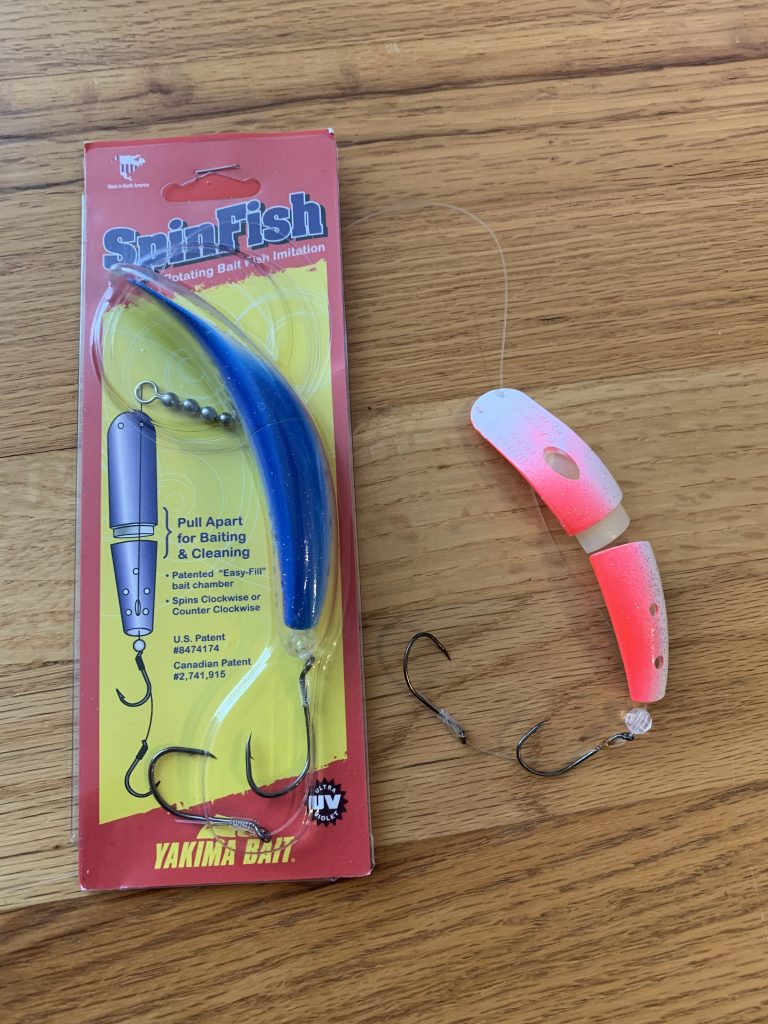
I had a chance to test out a couple of “must have” prototype lures this past summer courtesy of Buzz Ramsey, the Yakima Bait brand manager.
“You’ve got to try these,” Ramsey said. “They’re remarkable and sure to catch plenty of fish.”
I had a hard time convincing my fishing partner whom I’ll title as the “anonymous hard to change over angler” of putting one of these off the downrigger while fishing for coho. But after a few fruitless outings he relented into giving them a try.
When trolled or still-fished in the current the lure vibrates and has a fast action spin like a wounded-baitfish action. We filled the patented pull-apart “Easy-Fill” bait chamber and scent-dispersing design with herring strips and Pro-Cure Gel Scent and had very good success.
“I’m hooked and can’t believe how much action there is on the SpinFish,” said the anonymous hard to change over angler.
We rigged ours 35 inches behind a Pro-Troll Lighted Flasher on the downrigger but you can also put them behind a dodger or conventional sinker or simply all by itself.
The new SpinFish comes in two sizes – a 3-inch and 4-inch version – rigged and ready to fish with tandem hooks. The 3-inch size comes in 20 different colors while the 4-inch version comes in 10 colors and each are coated in a UV finish.
The SpinFish can be rigged to spin counterclockwise or clockwise.
Many anglers have already been seeking out this newest rage in lure design, and just like the current popular Brads Bait look for guides, tackle reps and others to be chatting up a storm about the SpinFish – the newest and latest and greatest lure soon to be on the sport-fishing market!
For details on the new SpinFish contact Yakima Bait at ybcinc@yakimabait.com or go to www.yakimabait.com.
Nibbles and bites
· There have been some good coho fishing reports coming out of local rivers like the Nooksack, Skagit, Cascade, Green and Stillaguamish mainstem. Overall most of the coho are small in the 4- to 5-pound range and a few 8 to 10 pounders. Other notable rivers include the Chehalis, Clearwater, Bogachiel, Calawah, Humptulips, Hoh, Willapa, Queets, Quinault, Sol Duc and Wynoochee. Anglers should check the WDFW regulation pamphlet, app or website for what is open and what type of salmon species you can target in each river system.
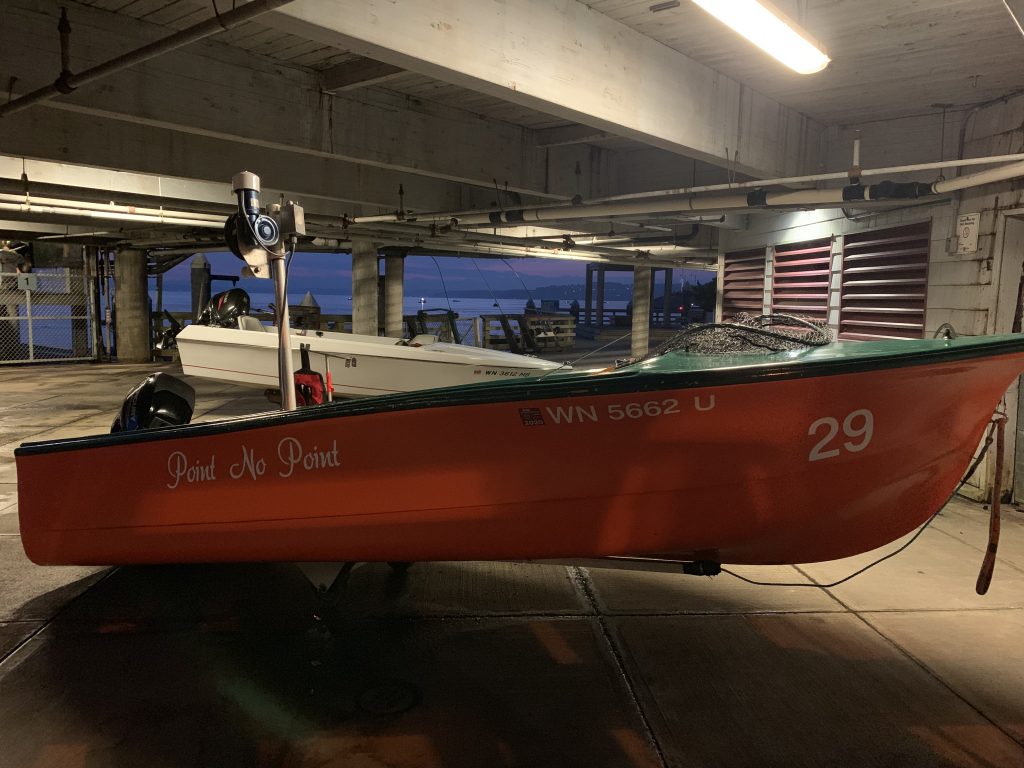
· In Central Puget Sound (Marine Catch Area 10) – open through Nov. 15 for salmon fishing – the coho action is downright dismal with most headed up the rivers but a few chums are starting to appear off Jefferson Head, West Point south of Shilshole Bay, Point Monroe, Kingston, Allen Bank and Southworth near Blake Island, and the east side of Bainbridge Island. A reminder that the daily catch limit has increased back to two coho, chum or hatchery chinook daily in southern Puget Sound (Area 13). The daily limit in Areas 10 and 8-1 are also two salmon but only one may be a coho. Area 8-1 is open through Oct. 31 and also release pinks and chinook. Area 10 you can keep chum, pink and coho but need to release chinook.
· Lake Stevens in Snohomish County remains good for kokanee although some of the male fish are starting to show some color. Further north Lake Cavanaugh is another decent bet for kokanee.
· Lake Washington remains very good for yellow perch, and a few coho are being caught in the section north of the 520 Bridge although it has been waning big time in recent days.
· Coastal razor clam diggers should get final approval very soon on the next series of night-time low tide digs scheduled for Oct. 26, 28 and 30 at Long Beach, Twin Harbors and Copalis; and Oct. 27, 29 and 31 at Long Beach, Twin Harbors and Mocrocks. More digs are also planned in November and December.
·The king action is winding down on the Columbia River in the Vernita-Hanford Reach areas and closes after Oct. 15 but there’s still a fairly good chance to catch fish in the 15- to 25-pound range with some pushing 40-plus pounds. The boat ramp just above Highway 24/Vernita Bridge on Columbia will place you right in front of the “King Hole,” which is a slot about 50 to 60 feet deep. There are other hotspots like the Hog Hole, and Midway Drift and China Bar Drift located above the King Hole.
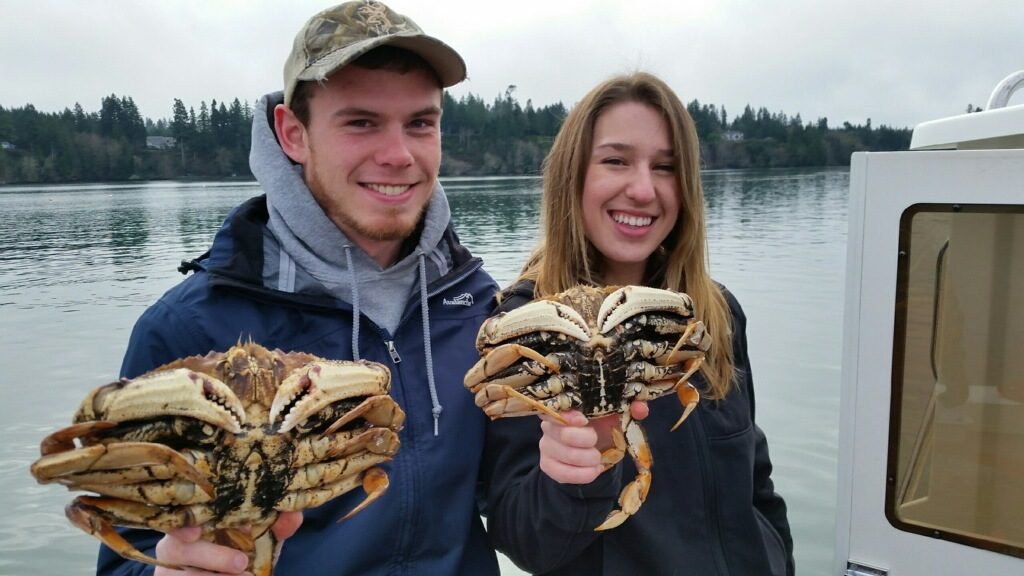
· The Dungeness crab fishing has been very good since it reopened Oct. 1, and will remain open daily through Dec. 31 at Neah Bay east of the Bonilla-Tatoosh line (Marine Area 4); Sekiu area in western Strait of Juan de Fuca (5); Port Angeles area eastern Strait of Juan de Fuca (6); San Juan Islands (7); Deception Pass, Hope Island, and Skagit Bay (8-1); Port Susan and Port Gardiner (8-2), and northern Puget Sound/Admiralty Inlet (9) except for waters south of a line from Olele Point to Foulweather Bluff.
Sport crabbers are reminded that setting or pulling traps from a vessel is only allowed from one hour before official sunrise through one hour after official sunset.
Sport crabbing is closed in central Puget Sound (10); south-central Puget Sound (11) and southern Puget Sound (13). It is still uncertain whether portions of Port Gamble/Port Ludlow (within 9) and Hood Canal – north of Ayock Point (12) will open for a shortened winter season. WDFW expects to announce a decision in the future on whether these areas will reopen. For more information, go to https://wdfw.wa.gov/fishing/shellfish/.


